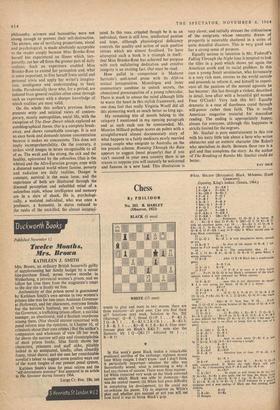Chess
By PHIL1DOR No. 203. B. HARLEY (Observer, 1923)
BLACK (8 men)
WHITE (13 men)
WHITE to play and mate in two moves; there are three solutions—all good ones. Can you find them all? Solutions next week. Solution to No. 202 (Hartong): Q—R 7, threat Q xP. 1 . . . P—Kt 3; 2 Q—R 7. 1 . . . R—Kt 3; 2 R XB. 1 . . B—Kt 3; 2 R—K 5. 1 . . . Kt—R 4; 2 R—Kt 6. Fine inter- ference play on Black's KKt 3: note also the thematic try 1 Q—QKt 2? defeated by 1 . . . R—B 3!.
In this week's game Black makes a remarkable positional sacrifice of the exchange; eighteen moves later White resigns. I don't know—and I don't think it particularly important—whether the offer was theoretically sound; what is interesting is why it had any chance of success. There were three reasons: (a) White remained very weak on the black coloured squares which Black was able to dominate—this was the central reason; (b) White had great difficulty in completing his development; (c) He could not co-ordinate his pieces. Try to improve on White's play and whether you succeed or not you will see how hard it was to break Black's grip. White, MILER! (BULGARIA). Black, fvfolnuNG (EAST GERMANY).
Opening, King's Indian. (Sinaia, 1964.)
1 P—Q 4 Kt—K83 2 P—QB 4 P—KKt 3 3 Kt—QB 3 B—Kt 2 4 P—K 4 P—Q 3 5 P—B 3 0-0 6 B—K 3 P—K 4 7 KKt—K 2 P—B 3 8 P—Q 5 PxP 9 BP XP P—QR 3 10 P—KKt 4 P—KR 4 11 P—KR 3 QKt--Q 2
12 B—Kt 5 . . . Premature. 12 Q—Q 2 is better. II 12 . . . Kt-13 4 then 13 P—Kt 4, QKt—Q 2: 14 Kt—B 11 with an excellent game, e.g. 14 . . . Kt—Kt 3; 15 Q—B 2, KKt—Q 2: 16 Kt—Kt 3 and then P—QR4-5 or 12 . . • Q—R 4; 13 P--QR 3 and 14 P--QKt 4. White should play to keep Black constricted.
12
13 15:2Q 2 QK—t—KRI 32. A very imaginative move, correct
or °L
14°B—K 7 . . . In view of the sequel 14 B—K 3 fol- lowed by PxP would be wiser.
14 . . . B—B 3! The remarkable idea. 14 .. • R—K I; 15 Kt—R 41. Q—B 2; 16 R—B 11 gives White 0 strong initiative.
15 BXR . . . After 15 B X B Black has a comfortable game.
15 . . B—R 5 ch •
16 K—Q I K xB 17 PxP . ._ 17 P—B 4 at once is a little better
(17 . . . PxP; 18 Q—Q 4) but Black's command of the black squares makes it very awkward for White anyway.
Ii, . B—Kt 5 18 P—B 4? .. • now this is too dangerous 11111 squeis
K 4 is very strong for Black. 18 Q—B 2 is better.
18 . . . KP X P 19 P—KR 4 B—R 3
20 PxP ... 20 Q—Q 4, P—B 6!: 21 Q—R 8 ch (21 QXQ, PXKt ch), K—K 2; 22 QXKl, Q—K 61—the meek squares. 20 . . is 3! Very fine. If 26 . . PxP then 21 Q—Q 4! ts strong because of the threat of Q--it 8 eh and then QxKt check.
21 B—R 3 Kt—K 4
22 Q—Q 4 . . . 22 R--QKt I. Kt—B 5: 23 Q—Q 3; Kt—K 6 ch (23 . .Kt xP ch: 24 K—B 2): 24 K--K I, p-.43 is also difficult for 'White (25 Kt—Q 4?' QXKt!) but may be rather better: text is an effort to break free at the cost of pawn.
22 . . . Q x P
23 R--QKt 1 Q--R 6 24 R—Kt 3 Q—R 4 25 BXB R X B 26 R—B 1 . . . here or next move Q—Kt 6 is met by 27 Q )(Q. R xQ; 28 P—B 6 winning a knight.
26 . . . R—B 5
27 Q—Q 2 Q—B 4 28 RXKtP KtxKtP 29 P—R 5? . . . Pointless loss of time. 29 R---Kt 3 ill Kt—K 4
better.. 30 12• XP . . . with the idea 30 . . BxR; 31 QX11 with counter-attack. If While sits tight Black will Oaf Kt (3)—Kt 5 threatening both P—B 6 and EL—K 6 ch.
30 . . . KtXKP!
31 RXKt? . . . he might as well resign as do this bo! 31 Kt XKt, RXKt is also quite lost for him, the threat being
32 . . . BxR; 33 Kt XB. R—Q 5 e,g. 32 R—Kt 3, B>'.'33 Kt XB. R--Q 5; 34 Kt—Q 3, QXP followed by a genersi exchange and a won ending-4f Black can find nothing mOr. B XQ
ding. Kt
32 It'XKt B X
33 Resigns
































 Previous page
Previous page